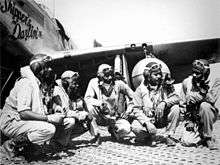Clarence D. Lester
Clarence D. “Lucky” Lester (February 23, 1923 – March 17, 1986) was an African-American fighter pilot in the 332nd Fighter Group, commonly known as the Tuskegee Airmen, during World War II. He was one of the first African-American military aviators in the United States Army Air Corps, the United States Army Air Forces and later the United States Air Force.[2][3] Lester was one of two pilots who shot down three Focke-Wulf Fw 190 or Messerschmitt Bf 109 on a single mission; the other pilot was Captain Joseph Elsberry. [4][5] Lester flew a P-51 Mustang nicknamed "Miss Pelt."[2]
Clarence D. Lester | |
|---|---|
 Lt Clarence Lester (right) with P-51 Mustang Group Fliers in Italy, 1944 | |
| Nickname(s) | Lucky |
| Born | February 23, 1923 Richmond, Richmond City, Virginia |
| Died | March 17, 1986 (aged 63) [1] Washington, District of Columbia, District Of Columbia, USA |
| Buried | Arlington National Cemetery, Virginia, USA |
| Allegiance | |
| Service/ | |
| Years of service | 1942-1969 |
| Rank | Colonel |
| Unit | 322nd Fighter Squadron Tuskegee Airmen |
| Battles/wars | World War II |
World War II
The Tuskegee Airmen is the popular name of a group of African-American military pilots (fighter and bomber) who fought in World War II. They formed the 332nd Fighter Group and the 477th Bombardment Group of the United States Army Air Forces. The name also applies to the navigators, bombardiers, mechanics, instructors, crew chiefs, nurses, cooks and other support personnel. Lester recalls that "Being a black pilot in the 1940s was like being a pro athlete today ... We knew we were special, that we would have to prove something. This was the first chance blacks had had outside of working in the kitchen or the possiblity [sic] of being a truck driver." [6] White pilots would fly around 50 combat missions but because there were no replacements, black pilots of the Tuskegee Airmen flew around 70 missions.[7] During the war he flew over 90 combat missions.[8]
After the WWII
While flying an F-84E Thunderjet it experienced mechanical failure and exploded into flames forcing Lester to yank his ejection seat and parachute from the inflamed jet, which made him "only the sixth pilot ever to use the ejection method." [8] Later in his career he also worked with the infamous "Whiz kids" that Robert McNamara assembled at the Office of the Secretary of Defense.[7] In 1969 Lester retired as a full colonel and was then appointed as associate director of social services in Rockville, Maryland.[7]
Bibliography
Notes
References
- Campbell, Crispin Y. (February 23, 1983). "Black Pilots Of '40s Charted New Horizons". Washington Post. Retrieved May 6, 2018.CS1 maint: ref=harv (link)
- Find a Grave (2018). "Col Clarence D. "Lucky" Lester". Find a Grave. Retrieved May 6, 2018.CS1 maint: ref=harv (link)
- Gubert, Betty Kaplan; Sawyer, Miriam; Fannin, Caroline M (2002). Distinguished African Americans in Aviation and Space Science. Greenwood Publishing Group. ISBN 9781573562461.CS1 maint: ref=harv (link) - Total pages: 319
- Hardesty, Von (2008). Black Wings: Courageous Stories of African Americans in Aviation and Space History. HarperCollins. ISBN 9780061261381.CS1 maint: ref=harv (link) - Total pages: 180
- Homan, Lynn; Reilly, Thomas (2001). Black Knights: The Story of the Tuskegee Airmen. Pelican Publishing Company. ISBN 9781455601257.CS1 maint: ref=harv (link) - Total pages: 336
- Nalty, Bernard C. (1989). Strength for the Fight: A History of Black Americans in the Military. Simon & Schuster. ISBN 9780029224113.CS1 maint: ref=harv (link) - Total pages: 424
- United States Air Force (February 8, 2012). "Tuskegee Airman gives account of 'lucky' day". United States Air Force. Retrieved May 6, 2018.CS1 maint: ref=harv (link)
- Viera, Bené (April 12, 2018). "This black fighter pilot broke all kinds of records. He doesn't even have a Wikipedia page". timeline.com. Retrieved May 6, 2018.CS1 maint: ref=harv (link)
